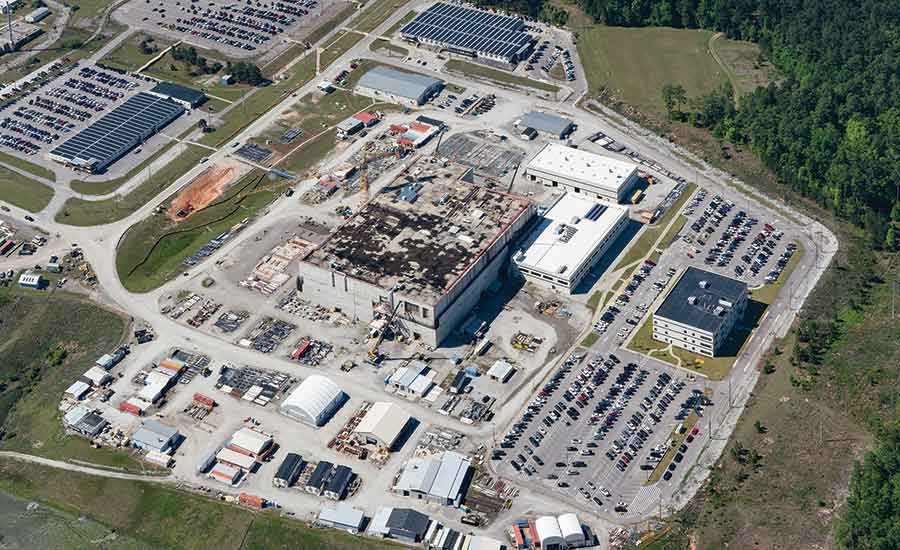DOE Seeks to Halt MOX Construction, Convert Facility to Nuclear Weapons Plant

The Mixed Oxide Fuel Fabrication Facility project, as pictured in late April. (PHOTO COURTESY OF HIGH FLYER (C) 2018)
With the idea of converting the unfinished MOX facility into a manufacturing plant for nuclear weapons components, Energy Secretary Rick Perry on May 10 waived the requirement to use funds on construction and related support activities for the massively over-budget project at Savannah River Site in South Carolina.
Perry’s waiver hasn’t killed the project yet, but is the most serious threat to do so, numerous sources tell ENR. The waiver was made through a new authority Congress granted to the Dept. of Energy under the 2018 National Defense Authorization Act (NDAA).
The action by Perry started a 30-day countdown to the actual halt of construction. In that time, numerous Hail Marys could transpire, including legal action by the state, other government entities and even the contractor, CB&I AREVA MOX Services, sources familiar with the project tell ENR.
The Mixed Oxide Fuel Fabrication facility, started in 2007, was originally designed to convert 34 metric tons of weapons-grade plutonium into commercial nuclear fuel for power plants under an agreement between the United States and Russia. Citing immense cost overruns and schedule delays, the Obama administration had been attempting since 2014 to move the project into “cold standby,” effectively suspending construction. But each time, Congress rebuffed those attempts.
The congressionally authorized NDAA waiver requires DOE to certify that an alternative exists for disposing of the plutonium, the cost for that alternative is less than 50% of the MOX method and the plutonium is removed from South Carolina.
The MOX program alternative, called dilute and dispose, involves “downblending” the weapons-grade plutonium and then storing it at New Mexico’s Waste Isolation Pilot Plant (WIPP). Perry’s letter noted DOE’s estimated the remaining life-cycle costs to implement dilute and dispose would be $19.9-billion, compared with $49.4-billion for the MOX program.
In 2016, the Dept. of Energy estimated contractor CB&I AREVA MOX Services would complete construction in 2048 at a total cost of nearly $17.2 billion. The project’s original completion target was 2016, with a budget of $4 billion.
This latest effort to kill MOX is meeting with strong opposition from South Carolina’s congressional delegation, including Rep. Joe Wilson (R) and Sen. Lindsey Graham (R).
Noting that they were “extremely disappointed,” the politicians criticized DOE for its handling of the MOX project, which they termed a “debacle.”
In the meantime, DOE and the National Nuclear Security Administration (NNSA) say the unfinished MOX structure—which has so far cost taxpayers approximately $5 billion—can be converted into a plutonium pit manufacturing plant. Plutonium pits are grapefruit-sized components of nuclear weapons that help initiate detonation. Currently, the U.S. has little to no pit production under way.
To upgrade the nation’s “defense plutonium capabilities,” the Dept. of Defense has set a goal to produce a minimum of 80 pits per year by 2030. The NNSA is recommending the MOX project be repurposed to produce 50 pits per year, with the remaining 30 pits produced at Los Alamos National Laboratory.
Dilute-and-Dispose Hurdles
The plans to implement the dilute-and-dispose approach and convert the existing MOX structure both must clear several hurdles before adoption.
First, the federal government must make a formal decision to abandon the MOX approach in favor of dilute and dispose. That hasn’t happened yet.
In an April 2018 letter to the Governor’s Nuclear Advisory Council in South Carolina, Jonathan Edwards, director of the EPA’s Office of Radiation and Indoor Air, stated that: “The EPA is not aware of any other Congressional decision or definitive DOE action that would indicate a decision has been made to use a ‘dilute and dispose’ approach.” The letter noted that because the studies and analyses required to move forward with dilute and dispose “would be expected to take many years, it is premature for the EPA to address the issue of the disposal at WIPP of the 34 MT of plutonium.”
While dilute and dispose may not yet be the official approach to plutonium disposition, the Union of Concerned Scientists believes it’s the best path forward. In a statement on the DOE’s plan to cancel MOX, UCS scientist Edwin Lyman said: “While the MOX program has gone well over-budget, we now know that the dilute-and-dispose process will be far cheaper.”
South Carolina’s Congressional delegation threw shade on DOE’s dilute-and-dispose aspirations in its statement denouncing Perry’s actions. The group, noting that “the MOX process was chosen over other alternatives and was the method agreed to with the Russians,” called the MOX program “one of the most important non-proliferation programs in the history of the world.”
Adding that dilute and dispose “has not been fully vetted,” the group stated: “If that was not enough, DOE has done almost nothing to consult with New Mexico – the state which would receive this material – and the political leadership in New Mexico has already expressed great concern about this change in course. Finally, the legal challenges to move from MOX in South Carolina to ‘dilute and dispose’ in New Mexico will be enormous. By any fair assessment, the viability and chance of success with dilute and dispose are, at best, questionable.”
Pit Production Possible?
An NNSA presentation from January 2018, entitled Plutonium Pit Production Analysis of Alternatives, notes a cost range of $1.4 billion to $5.4 billion for “refurbishing and repurposing facilities at the Savannah River Site,” such as the unfinished MOX structure. The presentation, which includes a “schedule range” of between FY 2024-2031, also notes the related risk of “reconfiguring a partially completed facility for a new mission in a new location.”
A May 10 NNSA statement advocates its proposed “two-prong approach” of producing plutonium pits at SRS and Los Alamos as “the best way to manage the cost, schedule and risk of such a vital undertaking.”
The statement adds that “the recommended alternative improves the resiliency, flexibility and redundancy of our nuclear security enterprise by not relying on a single production site.”
Tom Clements, director with the watchdog group Savannah River Site Watch, said: “Siting of new factories at SRS … to produce the plutonium components of nuclear weapons is a provocative move that will further stimulate a nuclear arms race and result in a host of nuclear waste and toxic waste streams.”
Noting that a “full-blown, nation-wide Environmental Impact Statement process will be legally required,” Clements added: “The environmental and arms control risks associated with new nuclear bomb facilities are high and will involve careful public review by citizens in South Carolina and elsewhere.”
Change of Missions?
If implemented, the repurposing of the unfinished MOX structure from a de-facto disposal of weapons-grade plutonium to producing components to be used in nuclear weapons would be akin to “adding insult to injury,” Lyman with UCS told ENR.
“Certainly trying to use that building to do any kind of processing is probably an invitation for a massive waste of money,” he added. “So, putting aside the issue of whether the U.S. needs a new pit facility or not, it's a stupid idea.”
DOD’s plan to revive the nation’s much-dormant plutonium-pit production capabilities presents another concern, Lyman adds.
“It's a very blurry line between what it is to extend the life of existing weapons and to alter the pits (in a way) that would constitute new capability,” he says, adding that “both options certainly would be available.”
“We don't support the need for the U.S. to develop new types of nuclear weapons,” Lyman continues. “We don't think it's necessary or desirable. That's an even worse reason to build it.”



